RISING STORM - THE IMPERIAL JAPANESE NAVY AND
CHINA
1931-1941
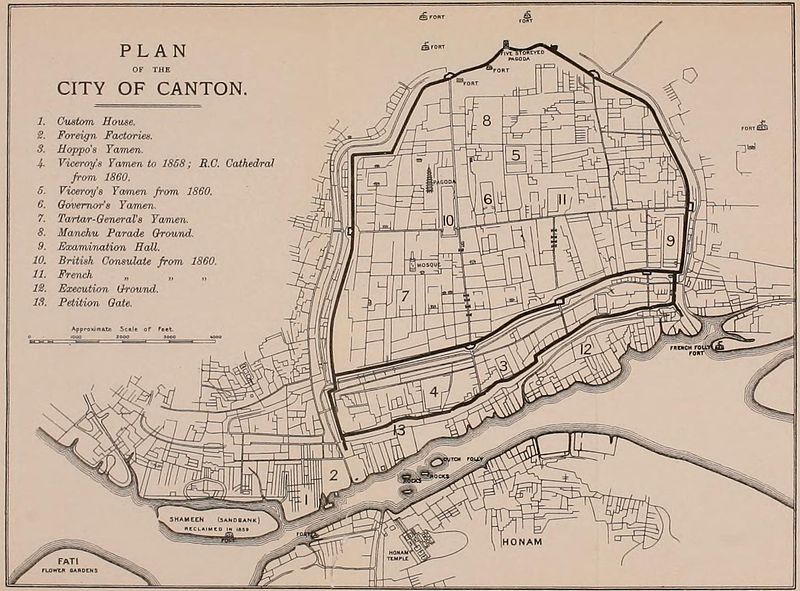 City of Canton in 1910 showing Shameen Island at lower left
City of Canton in 1910 showing Shameen Island at lower left
The Campaign to Seize Canton (Guangzhou) - 1937 - 1938
© 2012 Bob Hackett, Sander Kingsepp and Anthony Tully
Revision 4
Canton (now Guangzhou), for over 1,000 years the great trading port of South China, lies on the delta of the Pearl River, 75 miles north-northwest of Hong Kong. Canton was the third largest city in China and the largest in southern China. The Portuguese are the first Europeans to arrive in Canton in 1514. By 1517, they establish a monopoly on external trade from the port, until the Chinese expel them.
By the 1690s, the French and English began trading in the port. In the 1700s, they are followed by Dutch, Danish, Swedish, Prussian, Italian, American and Australia companies. Between 1757 and 1842, the Qing government officially opens Canton to foreign trade including Portuguese, Spanish, Arab and Indians and it becomes one of the world's great trading ports. In 1841, during the First Opium War the British capture Canton. In 1842, the Treaty of Nanking ends the First Opium War and Cantou's monopoly on trade between Britain and China by opening four new treaty ports in Fuzhou, Amoy (Xiamen), Ningbo and Shanghai. The Treaty also cedes Hong Kong to Britain.
Sometime after the end of the Second Opium War (Arrow War) in 1858, British and French traders create Foreign Concessions on tiny Shameen (Shamian) Island. European traders then reside there in colonial style buildings and work under European laws.
By the 1930s, one-third of the city's 1,000,000 Chinese live on water-logged sampans, jam-packed along the river fronts.
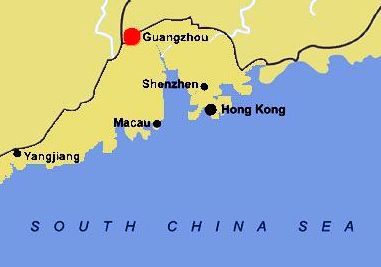 Southern China showing Canton (Guangzhou), Macau and Hong
Kong
Southern China showing Canton (Guangzhou), Macau and Hong
Kong
1932:
The United States Asiatic Fleet (USAF) South China Patrol continues to operate in the Canton-West River area to protect United States nationals and other interests in the area. Old gunboat USS HELENA is withdrawn and decommissioned, leaving only river gunboat MINDANAO (PR-8), flagship of the South China Patrol, in the Canton area.
7 July 1937: The Marco Polo Bridge Incident ("First China
Incident"):
Hun River, Lukuokiao, China. Imperial Japanese Army (IJA) troops on night maneuvers at the Marco Polo Bridge fire blank cartridges. Chinese troops across the river think they are under attack. They fire live rounds back, but do not cause injuries. At morning roll call, the Japanese discover a soldier missing and assume the Chinese have captured him. The Japanese demand entry to the Peiping (Beijing) suburb of Wanping to look for the soldier, but the Chinese refuse. The Japanese then shell the city. An undeclared war on China begins.
15 August 1937:
Japanese residents in South China are under the protection of Rear Admiral (later Vice Admiral) Okuma Masakichi's (37)(former CO of YAMASHIRO) DesRon 5. DesDiv 13's SANAE is responsible for Canton. After the clash in Shanghai, Japanese residents in Canton start evacuation. All reach Formosa safely.
31 August 1937:
Taipei, Formosa (Taiwan). The IJN Kanoya Kokutai (Naval Air Group) launches nine (Type 96 Mitsubishi G3M2 "Nell" bombers to cross the East China Sea and attack Canton. The Chinese 29th Independent Pursuit Squadron (PS) scrambles eight Curtiss "Hawk III" fighters to intercept. The Chinese shoot down one G3M. Two of the Hawks are slightly damaged.
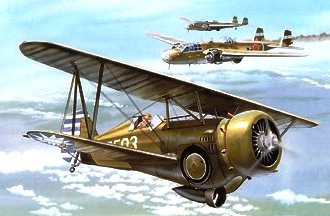 Chinese "Hawk III" and IJN G3M2 "Nells"
(Classic Airframes box art)
Chinese "Hawk III" and IJN G3M2 "Nells"
(Classic Airframes box art)
5 September 1937:
CarDiv 1's RYUJO and HOSHO depart Sasebo.
21 September 1937:
South China coast. CarDiv 1's HOSHO and RYUJO begin operations against Chinese forces near Canton despite bad weather. The Chinese 29th PS scrambles seven Curtiss "Hawk III " bi-plane fighters to intercept an attack on the Teinho and Peiyun airfields by 12 Type 94 dive-bombers, three torpedo bombers and 15 Type 90 fighters. A 30-minute dogfight ensues in which two "Hawk IIIs" are shot down. The Japanese also shoot down two Chinese observation planes. Five of HOSHO's fighters run out of fuel and are forced ditch short of the carrier. IJN destroyers and other vessels rescue the pilots. This is the largest single loss of IJN fighters during the Sino-Japanese War, 1937-1941.
That afternoon, RYUJO launches six carrier bombers, three atttack planes and nine fighters to attack Canton. They are engaged by CAF "Hawk III" fighters. RYUJO's pilots claim five "Hawk IIIs" shot down.
22~30 September 1937:
CarDiv 1's aircraft fly almost daily attack missions in the vicinity of Canton.
3 October 1937:
CarDiv 1 departs Cantonese waters for the Shanghai area.
4 October 1937:
KAGA departs Sasebo.
E 7 October 1937:
KAGA arrives off Canton.
E 8-23 October 1937:
KAGA’s aircraft engage in missions against Chinese positions in the vicinity of Canton.
E 24 October 1937:
KAGA departs Chinese waters.
21 November 1937:
KAGA departs Sasebo.
E 24 November 1937:
Arrives in the vicinity of Canton.
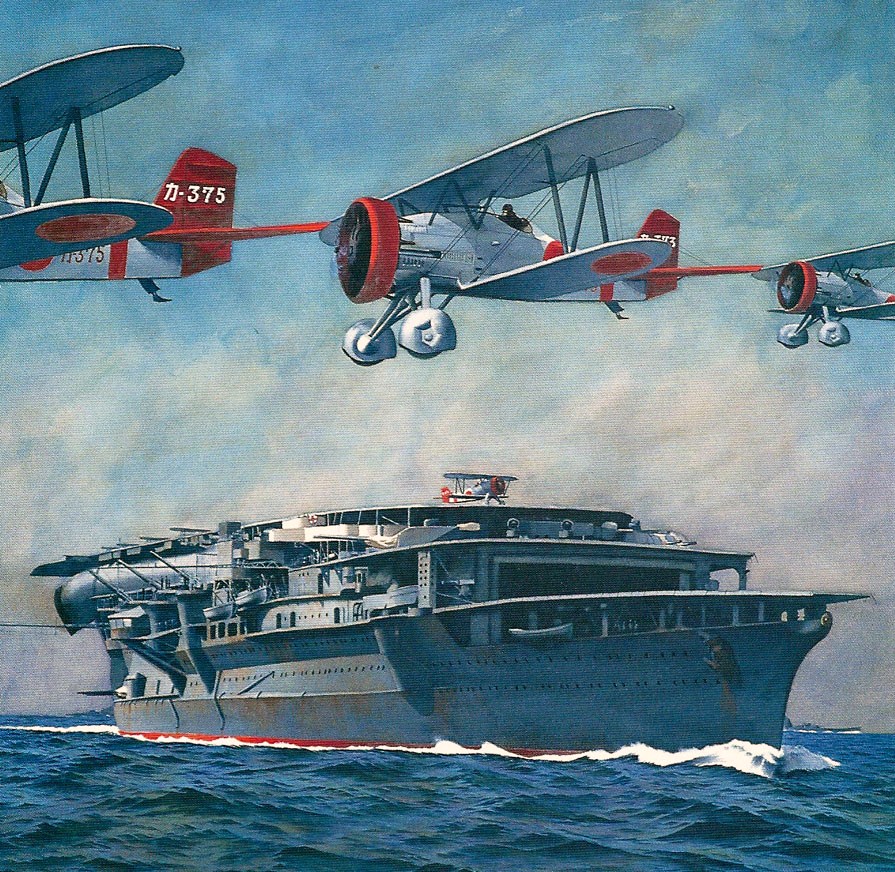 IJN KAGA and Nakajima Type 95 fighters
E 24-29 November 1937:
IJN KAGA and Nakajima Type 95 fighters
E 24-29 November 1937:
KAGA’s aircraft engage in missions against Chinese positions in the vicinity of Canton.
E 29 November 1937:
KAGA departs Chinese waters. Some of her aircraft are detached to land bases.
10 December 1937:
KAGA departs Sasebo.
E 14 December 1937:
KAGA arrives off Canton.
E 14 December 1937~21 January 1938:
KAGA’s aircraft engage in ground support missions in the vicinity of Canton.
28 December 1937:
The South China Sea Fleet departs Mako, Pescadores on a Chinese Blockade sortie, probably bound for Liantang Sanzao.
17 January 1938:
Pearl River Delta. Vice Admiral (later Admiral) Shiozawa Koichi’s (32)(former CO of FURUTAKA) South China Sea Fleet (soon renamed 5th Fleet) assault Liantang Bay, Sanzao (Sanzhao) Dao (now in Zhuhai City). Koichi’s forces consist of six to eight unidentified transports covered by CruDiv 9's cruiser MYOKO (F) and light cruiser TAMA, Desron 5's light cruiser NAGARA and DesDiv 16's ASAGAO, FUYO and KARUKAYA, DesDiv 23's ASANAGI and YUNAGI and DesDiv 28's MUTSUKI, MOCHIZUKI, MIKAZUKI and KIKUZUKI. In addition to carrier KAGA, air cover is provided by seaplane tenders NOTORO and KAMIKAWA MARU and possibly KAMOI.
The naval force lands a large force of IJA, IJN Special Naval Landing Force (SNLF) troops and construction personel. The Japanese intend to use Sanzao Island as a base for the invasion of Canton. Japanese troops quickly overrun the island and commit atrocities. [1]
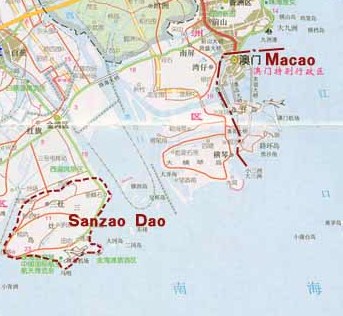 Sanzao Island near (then) Portuguese Macau
Sanzao Island near (then) Portuguese Macau
28 February 1938:
KAGA departs Yokosuka.
3 March 1938:
KAGA arrives off Canton. Nine of KAGA fighters are temporarily based at Nanking (Nanjing).
E 15 March-5 April 1938:
CarDiv 2’s SORYU and RYUJO's aircraft operate in support of the offensive against Canton. SORYU’s units include Yokosuka B4Y1 attack
bombers, D1A2 dive-bombers and A4N1 and A5M fighters.
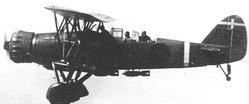 B4Y1 attack bomber
B4Y1 attack bomber
4 April 1938:
KAGA’s detached fighters return to the carrier.
8 April 1938:
The Japanese massacre some 1,000 Chinese civilians on Sanzao Dao. [2]
13 April 1938:
At 0830, 18 D1A2 bombers escorted by three A4N1 and 3 A5M2 fighters take-off from KAGA to bomb Tien He airbase. They are intercepted over their target by 18 Gloster "Gladiator" bi-plane fighters of the Chinese 28th and 29th Pursuit Squadrons. During the 40 minute aerial combat, one IJN A5M2 , two A4N1s and two Aichi D1A2s are lost as are four CAF "Gladiators."
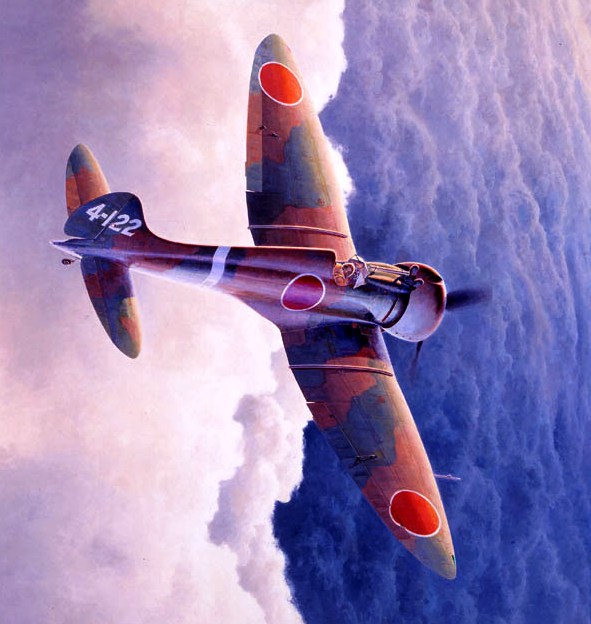
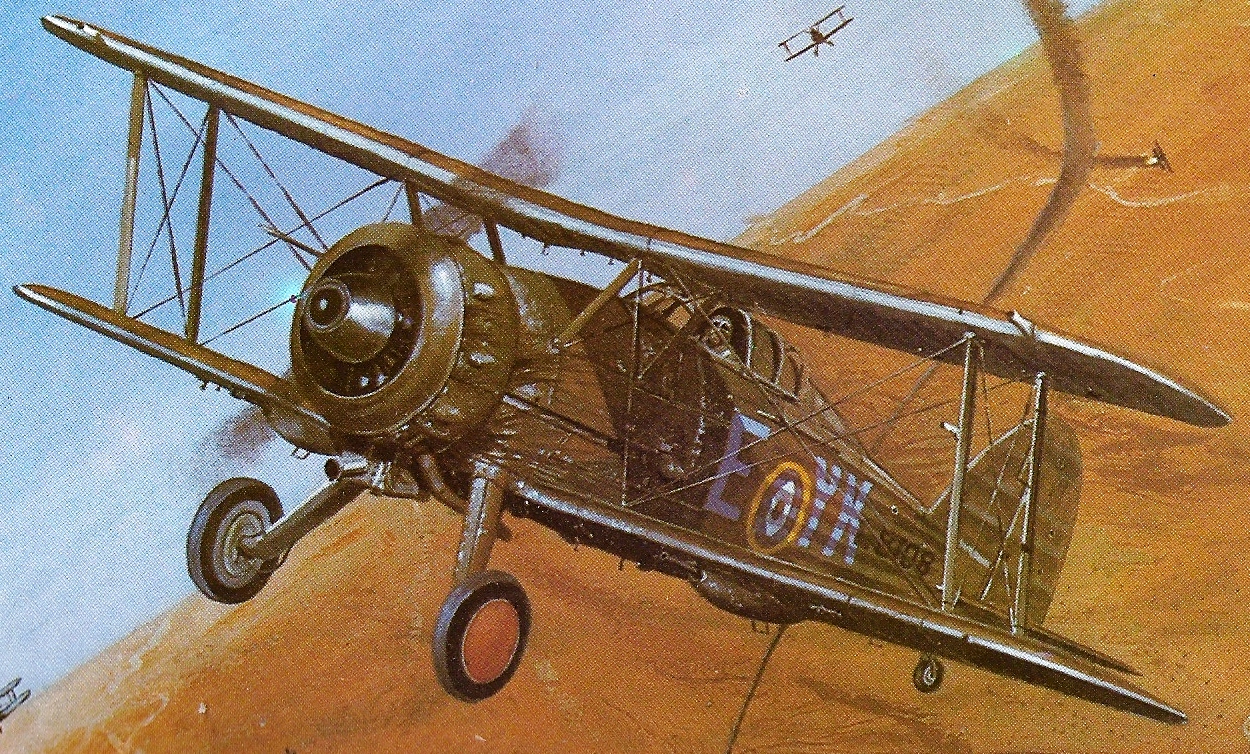 IJN Mitsubishi A5M2 "Claude" and Gloster "Gladiator" in RAF markings
1 May 1938:
IJN Mitsubishi A5M2 "Claude" and Gloster "Gladiator" in RAF markings
1 May 1938:
The air base is completed on Sanzao Island (now Zhuhai International Airport) and occupied by the IJN 14th Naval Air Group (NAG), a dive bomber group, probably equipped with Aichi D1A2s. After the air base construction is completed, the Japanese execute more than 3,000 migrant workers. Many of the island’s residents also starve to death during the Japanese occupation.
At an unknown date, the Chinese Air Force bombs Sanzao Island and destroys many buildings and equipment and possibly damages Japanese ships and aircraft.
June 1938:
Japanese bombs fall on the grounds of the U. S.-owned Lingnan University, the oldest Christian college in South China. Other bombs destroy a side of the French Paul Doumer Hospital across the narrow canal from Shameen Island's foreign concession.
8 June 1938:
United States Ambassador Joseph C. Grew lodges a protest with Tokyo against the bombing of Lingnan University. The French Government protests the attack on the French hospital. In Shanghai, the chief of the IJN's Press Department, Rear Admiral (later Vice Admiral) Kiyoshi Noda (35)(former XO of KINU) announces that Japanese aerial bombardments will continue. He expresses "satisfaction with the progress of military operations" to date and assures that "our aviators are doing their best to avoid hitting non-combatants."
30 August 1938:
Five bombers, four B4Y1 attack planes escorted by six A5M4 fighters attack an airfield near Canton. They are intercepted by Chinese 32nd PS "Gladiators" A 40-minute battle ensues during which two IJN fighters and six Gladiators are shot down.
14 September 1938:
The 14th NAG at Sanzao Island steps up its dive-bombing attacks in the Canton area.
7 September 1938:
The Imperial Conference authorizes the 21st Army to conduct the landing at Canton.
7 September 1938:
The list of participating units for the landing at Canton is approved.
2 October 1938:
The HQ of the 21st Army arrives at Makung (Mako), Pescadores.
10 October 1938:
The IJN finishes preparations for the landing.
12 October 1938: Operation "Z":
Ta-Ya (Bias Bay), 35 miles NE of Hong Kong. At dawn, Vice Admiral Shiozawa’s 5th Fleet assaults Canton in a surprise landing. Koichi’s forces consist of CruDiv 9's cruiser MYOKO (F), light cruisers KINU, JINTSU and TAMA, DesRon 5's light cruiser NAGARA and DesDiv 16's ASAGAO, YUGAO, FUYO and KARUKAYA, DesDiv 23's KIKUZUKI, MIKAZUKI, MOCHIZUKI and YUZUKI, DesDiv 28's YUNAGI and ASANAGI. The total number of the ships participacing in the landing is about 100 including attached Army Landing Craft Depot Ship IJA SHINSHU MARU. The naval force lands LtGen Furusho Motoo’s 21st Army comprised of LtGen Ando Rikichi’s 5th Division, LtGen Kuno Seiichi’s 18th Division and LtGen Miyake Toshio’s 104th Division.
The offensive is supported by carriers KAGA, SORYU and RYUJO, seaplane tenders CHITOSE, on her first operational deployment, and KAMIKAWA MARU, Formosa-based aircraft and 21st Army’s MajGen Fujita Tomo’s 4th Flight Group. Thereafter, Japanese forces continue their advance with little or no resistance.
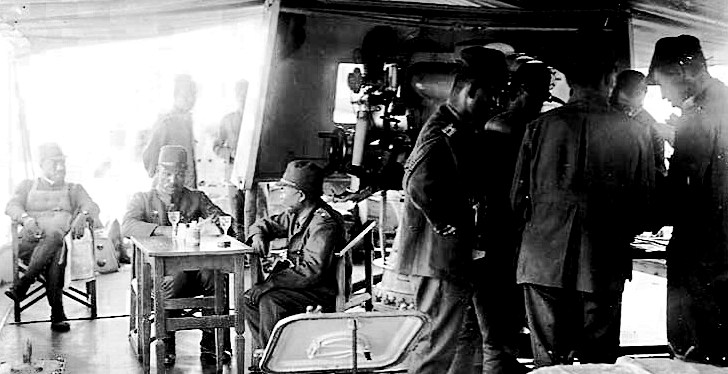 IJA 5th Division, 42nd Regiment's CO aboard IJN minesweeper W-18 at Canton
IJA 5th Division, 42nd Regiment's CO aboard IJN minesweeper W-18 at Canton
13 October 1938:
The HQ of the 21st Army is transferred ashore.
21 October 1938:
After heavy bombing for several months, most of the city's inhabitants have fled. Japanese troops arrive from the East and seize Canton, virtually unopposed, but the Chinese have applied a "scorched earth policy" and set the city afire.
22 October 1938:
The IJA 5th Division lands at Tykoktow Island, captures Humen (S of Canton).
23 October 1938:
IJN Special Naval Landing Force (SNLF) units land and support the 5th Division's advance towards Foshan by 11 November.
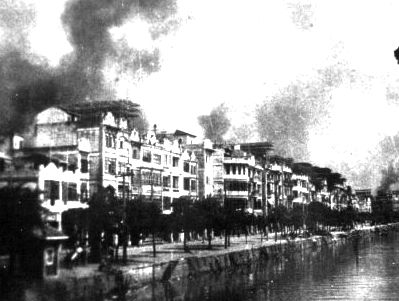 View of Canton burning from the British Concession
29 October 1938:
View of Canton burning from the British Concession
29 October 1938:
Canton. The first IJN units arrive in the harbor and raise the Rising Sun flag on the Customs buoy. By this time, most Europeans have left Shameen for Hong Kong.
River gunboats HMS MOTH (later IJN SUMA), HMS CICADA and USS MINDANAO remain on station in Canton exercising their countries' treaty rights. The IJN does not allow Chinese or British merchant ships to leave Canton, but does not stop the gunboats which ferry mail, medical supplies and official visitors between their Consulates in Canton and Hong Kong.
 Btitish river gunboat HMS MOTH
Btitish river gunboat HMS MOTH
E November 1938:
IJN CarDiv 2 departs Cantonese waters.
11 December 1938:
KAGA arrives at Sasebo.
15 December 1938:
Prior to her conversion to a seaplane tender, transport KAMIKAWA MARU is attached to the 5th Fleet's newly formed 16th Seaplane Tender Division with the 14th NAG’s assets. She operates from off Hainan Island in support of operations in the Canton area.
Authors' Notes:
[1] The authors could not find any extant data on the IJN OOB at Sanzao. Readers who have such info are requested to
post it on the Questions and Discussions Board and/or on the J-Air message board.
[2] Post war, the Chinese erect a memorial at Liantang in remembrance of those murdered in the cause of Japan creating a "Greater East Asia Co-Prosperity Sphere".
Thanks go to David Aiken of Hawaii and Rev. Sidnei Maneta of Sao Paulo, Brazil for additional IJN aircraft info in Rev 1.
Thanks also go to Allan Alsleben of Oregon for additional info about the Liantang Sanzao OOB in Rev 2.
-Bob Hackett, Sander Kingsepp and Anthony Tully
Back to Rising
Storm Page















